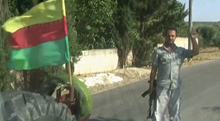A number of different symbols have been used to represent the Autonomous Administration of North and East Syria (NES), commonly known as Rojava. The Autonomous Administration adopted an official emblem in December 2018. The emblem consists of the words "Autonomous Administration" in Arabic, surrounded by seven red stars representing the regions of northeast Syria, as well as a branch of olives and spike of wheat, two crops grown in the region. Surrounding all of the symbols is the words "Autonomous Administration of North and East Syria" written in Arabic, Kurmanji, Syriac, and Turkish, the languages spoken in the region. The blue and yellow semicircles the whole emblem is put upon represents the Euphrates river and the "permanent spring" of the region.[1] A flag with the Autonomous Administration's emblem on a white field is also used occasionally to represent the Administration itself.[2][3]
| Emblem of North and East Syria | |
|---|---|
 | |
| Armiger | Autonomous Administration of North and East Syria |
| Adopted | 2018 |
| Motto | Arabic: الإدارة الذاتية لشمال وشرق سوريا Kurdish: Rêveberiya Xweser a Bakur û Rojhilatê Sûriyeyê Classical Syriac: ܡܕܰܒܪܳܢܘܬ݂ܳܐ ܝܳܬ݂ܰܝܬܳܐ ܠܓܰܪܒܝܳܐ ܘܡܰܕܢܚܳܐ ܕܣܘܪܝܰܐ Turkish: Kuzey ve Doğu Suriye Özerk Yönetimi (Autonomous Administration of North and East Syria) |

One of the most commonly used flags, especially in Kurdish-majority areas, is the tricolor flag that was adopted by the Movement for a Democratic Society (TEV-DEM), a prominent democratic confederalist organization in the region.[4] The green, yellow and red colors are traditionally associated with Kurdish people, for example in the modern Flag of Kurdistan.[5][6][7] A horizontal tricolor with blue, yellow, and red is used by the Syriac Union Party and its military wing in areas with a significant Syriac-Assyrian presence.[8]
Symbols used by the Administration edit
-
Flag used by Autonomous Administration authorities since 2018, consisting of the Administration's emblem superimposed on a plain white background.
-
Official emblem of the Administration since 2018
-
De facto emblem of Rojava until 2018
-
Seal of the Syrian Democratic Council
-
Flag of the Syrian Democratic Forces, the official defense force of the Autonomous Administration of North and East Syria.
Other symbols commonly used in North and East Syria edit
-
The Tricolor flag of TEV-DEM, adopted circa 2012, commonly used by Kurds in Syria and widely regarded as a de facto symbol of the administration.
-
Tricolor used by the Syriac Union Party representing Syriac-Assyrian people in North and East Syria.[8]
-
The Kurdish flag used by Kurdish parties such as the Kurdish National Alliance in Syria.
-
The Assyrian flag used by the Syriac Military Council, the Khabour Guards and Nattoreh among others.[11][12]
-
Syrian independence flag, used by the Syrian National Democratic Alliance and several SDF groups, including the Northern Democratic Brigade and the Army of Revolutionaries.
-
Official flag of the Syrian Government, commonly used in Rojava following the negotiated entry of the Syrian Army in the aftermath of the 2019 Turkish offensive.[13][14]
Symbols of sub-regions edit
-
Flag of the Afrin Region[15]
-
Seal of the Euphrates Region[16]
-
Seal of the Jazira Region[17]
See also edit
References edit
- ^ Media Office. "Announcement – New coat of arms for the Democratic Self-Administration". Self-Administration of North & East Syria Representation in Benelux. SA-NES. Retrieved 4 February 2019.
- ^ "Autonomous Administration proposes congress on ISIS prisoners". Ajansa Nûçeyan a Firatê 2019. ANF English. 6 April 2019. Retrieved 17 April 2019.
- ^ "DAA intends to hold Islamic Conference". Hawar News. 15 April 2019. Retrieved 17 April 2019.
- ^ Wes Enzinna (24 November 2015). "Dream of Secular Utopia in ISIS' Backyard". The New York Times.
- ^ AFP (21 March 2009). "A masked Kurdish man waves a PKK's flag". Getty Images. Retrieved 17 May 2018.
- ^ Gutterman, Dov (25 February 1999). "Related (?) flags". Flags Of The World (FOTW). CRW Flags. Retrieved 17 May 2018.
(Find original article mentioned?)
- ^ Ballout, Mohammed (15 November 2012). "Syrian Kurds ready to fight an imminent battle for Qamishli city". Ekurd Daily. Kurd Net. Retrieved 17 May 2018.
- ^ a b "Syriac flags adorn the city of Hasaka". Syriac Military Council. 20 March 2017.
- ^ "Berlin'de Rojava temsilciliği açıldı" (in Turkish). Evrensel. 7 May 2016.
- ^ http://rojavabenelux.nl/
- ^ "Declaration of establishment by Syrian Democratic Forces". Kurdish Info. 15 October 2015.
- ^ "Archived copy". Archived from the original on 2017-10-09. Retrieved 2018-04-02.
{{cite web}}: CS1 maint: archived copy as title (link) - ^ "As Assad's forces return to northeast Syria, many Kurds worry that their new freedoms will be wiped out". The Independent. 2019-10-15. Archived from the original on 2022-05-26. Retrieved 2019-11-03.
- ^ Sanchez, Raf (2019-10-14). "Assad troops enter north-east Syria after Russia-backed deal with Kurds". The Telegraph. ISSN 0307-1235. Retrieved 2019-11-03.
- ^ "Self Administration". cantonafrin.com. Archived from the original on 23 October 2018. Retrieved 10 October 2019.
- ^ "Herême Firatê". Facebook. Retrieved 10 October 2019.
- ^ Hisên, Mihyedîn (5 March 2016). "Kantona Cizîrê sîstema federalîzmê gotûbêj kir". www.rudaw.net (in Kurdish). Retrieved 10 October 2019.